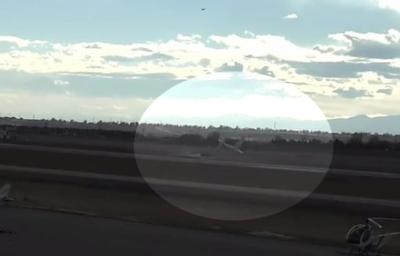Wed, Feb 04, 2015
Pilot Told NTSB He Thought He'd Allowed Enough Time For Them To Dissipate
This pilot thought he'd done everything right, as is evidenced by the NTSB's preliminary report. But at the end of the day, the pilot was seriously injured and the Cirrus SR20 he was flying was badly damaged. It's a rare instance in which a security camera caught the entire accident sequence, and we thought it would be instructional for our readers to see.

According to the NTSB, on December 5, 2014, about 1435 central standard time, a Cirrus SR20 airplane, N407ND, impacted terrain during approach at the Fort Collins-Loveland Municipal Airport (FNL), near Fort Collins, Colorado. The solo student pilot was seriously injured and the aircraft was substantially damaged. The aircraft was registered to and operated by Cirrus LLC under the provisions of 14 Code of Federal Regulations Part 91 as an instructional flight. Day visual meteorological conditions prevailed for the local flight, which departed without a flight plan.
The student pilot stated that he entered the traffic pattern at FNL for a full stop landing on Runway 33. He observed a Sikorsky UH-60 helicopter on downwind and delayed his turn to base until the helicopter was on final, abeam his position. While on final, the student pilot adjusted his aim point to land long, as he was concerned with wake turbulence and wanted to land beyond the helicopter's touchdown point. Just prior to landing, he encountered turbulent air and attempted to go around. The airplane subsequently impacted terrain and cartwheeled, which resulted in damage to the fuselage and wings.
An airport surveillance camera at FNL captured the accident airplane approaching the runway about 30 seconds in trail of the UH-60 helicopter.
At 1435 the weather observation station at FNL reported the following conditions: wind 110 degrees at 3 knots, visibility 10 miles, clear sky, temperature 14 degrees Celsius (C), dew point 4 degrees C, altimeter setting 30.22 inches of mercury.
(Image from YouTube video)
More News
Its Offerings Are Lighter, Cleaner, and Now Pushing Past 1,000nm on SAF Jet Fuel DeltaHawk’s diesel-powered aircraft lineup has seen incredible upgrades over the last few yea>[...]
The Airplane Experienced A Total Loss Of Engine Power On December 3, 2025, about 1600 central standard time, a Mooney Aircraft Corp. M20K, N57229, was substantially damaged when it>[...]
Make Sure You NEVER Miss A New Story From Aero-News Network Do you ever feel like you never see posts from a certain person or page on Facebook or Instagram? Here’s how you c>[...]
Aero Linx: European Society of Aerospace Medicine (ESAM) As a pan-European, independent forum, it works to promote the safety and health of all persons involved in aviation and spa>[...]
“We are excited to see Wisk achieve this milestone, and I’m so proud of the team that made it possible. The team at Wisk has built advanced technologies across flight c>[...]
 Aero-TV: DeltaHawks Diesel Power Steps Into the Spotlight
Aero-TV: DeltaHawks Diesel Power Steps Into the Spotlight NTSB Prelim: Mooney Aircraft Corp. M20K
NTSB Prelim: Mooney Aircraft Corp. M20K ANN FAQ: Turn On Post Notifications
ANN FAQ: Turn On Post Notifications ANN's Daily Aero-Linx (12.20.25)
ANN's Daily Aero-Linx (12.20.25) Aero-News: Quote of the Day (12.20.25)
Aero-News: Quote of the Day (12.20.25)



